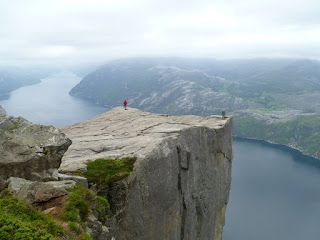We were all pretty knackered after the long walks we’d done in the previous week....

...so we hopped on a ferry at Tau and headed to Stavanger. The town is perhaps most famous for two things; sardines and oil (that’s the thick black stuff, not the stuff you put on your salad!)

The story of deep sea oil and gas exploration in Norway is an intriguing one. Oil was first discovered under the North Sea in 1969 and, having used some of the profits to develop the country’s infrastructure and pay off the national debt, the government started saving up.
The fund will provide pensions and healthcare for future generations of Norwegians and it now stands at a whopping $450 billion!! Norway is one of the world’s richest nations, one of the biggest investors, and one of the biggest producers of fossil fuels.

The petroleum museum in Stavanger is very interesting but it’s a little ‘rose-tinted’. Some sections are sponsored by the likes of BP and Statoil (the government oil company) and want to tell you just how great oil is.
In quite a contrast to this, we really enjoyed the little Canning Museum. Based in an old sardine cannery in Gamle Stavanger (the old town), the museum takes you through the whole process of preparing, smoking and canning. With thousands of little rubber fish standing in for the real things, you don’t even have the smell to deal with!
We really enjoyed Stavanger with its busy little harbour and narrow cobbled streets of colourful wooden buildings.

Moving north we headed towards Sorfjord, one of the branches off Hardangerfjord, passing some quite spectacular waterfalls on the way - the first of many!
This is a picture of Langfossen, the 5th highest waterfall in Norway, where the water drops 612 metres. To get an idea of scale, look closely for the road bridge at the bottom of the waterfall.

Having passed the dual waterfalls of Latefossen....

..we took a slight detour to climb up to the Buerbreen glacier. It was a great walk with a number of steep sections that had ropes attached so you could haul yourself up!


We spent a couple of days exploring the tiny villages around Hardangerfjord.
Eidfjord was a pleasant but rather quiet place. The nearby Voringsfossen waterfalls were impressive, as was the view from Kjeasen Farm, a very isolated place perched high on the mountainside. It’s a shame it was a bit grey and rainy at that point so we couldn’t fully appreciate it.


After a quick stop at Steinsdalfossen near Norheimsund, a 50 metre-high waterfall that you can walk behind, we found ourselves in Bergen.

There are quite a few toll roads in Norway. In most cases you drive straight through and either pay at a petrol station, through an online account, or you receive an invoice in the post. We’re on a budget and although it’s impossible to completely avoid the toll roads (in most cases there are no other options), we are trying to minimise their use.
So it was a little... well, let’s say ‘frustrating’ to find ourselves a bit lost in Bergen; going round in circles and passing under the toll cameras several times!!
Our guide book says it rains, often relentlessly, 260 days a year in Bergen! So you can imagine our surprise to be there in glorious sunshine. We made the most of it and spent a good few hours wandering.
Bryggen is the most popular area of the city. The former dock, which was an important trading port of the Hanseatic League, is the quintessential Norwegian image. The buildings are lucky to still be around as the city council wanted to tear them down after a fire in 1955. It was only after important archaeological remains were found that the colourful wooden buildings were given a reprieve.


Later that day we took the funicular railway up the hill behind the city to see the amazing view.

Every country has its own particular line in tourist tat. It’s black cabs and double deckers in London, bulls and sombreros in Spain, and in Norway it’s mini moose and trolls! You see them everywhere. The best known mythical character from Norwegian traditional folk tales is the troll; known to live under bridges and harass billy goats. See if you can spot the troll in this particular picture...

Oh, and there’s a moose in this picture...

After a good night’s sleep in a little spot on the hillside behind Bergen, we headed north. But not before we'd passed under another of the city's bloody toll cameras!

































